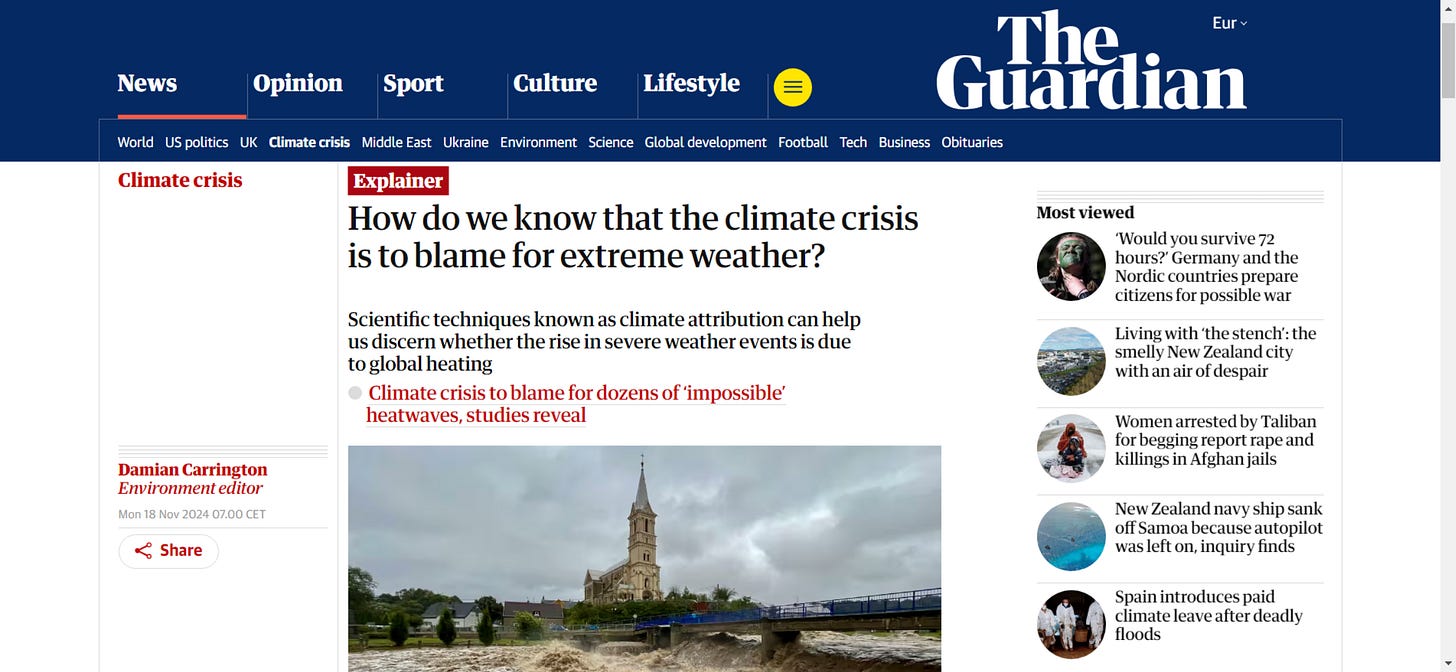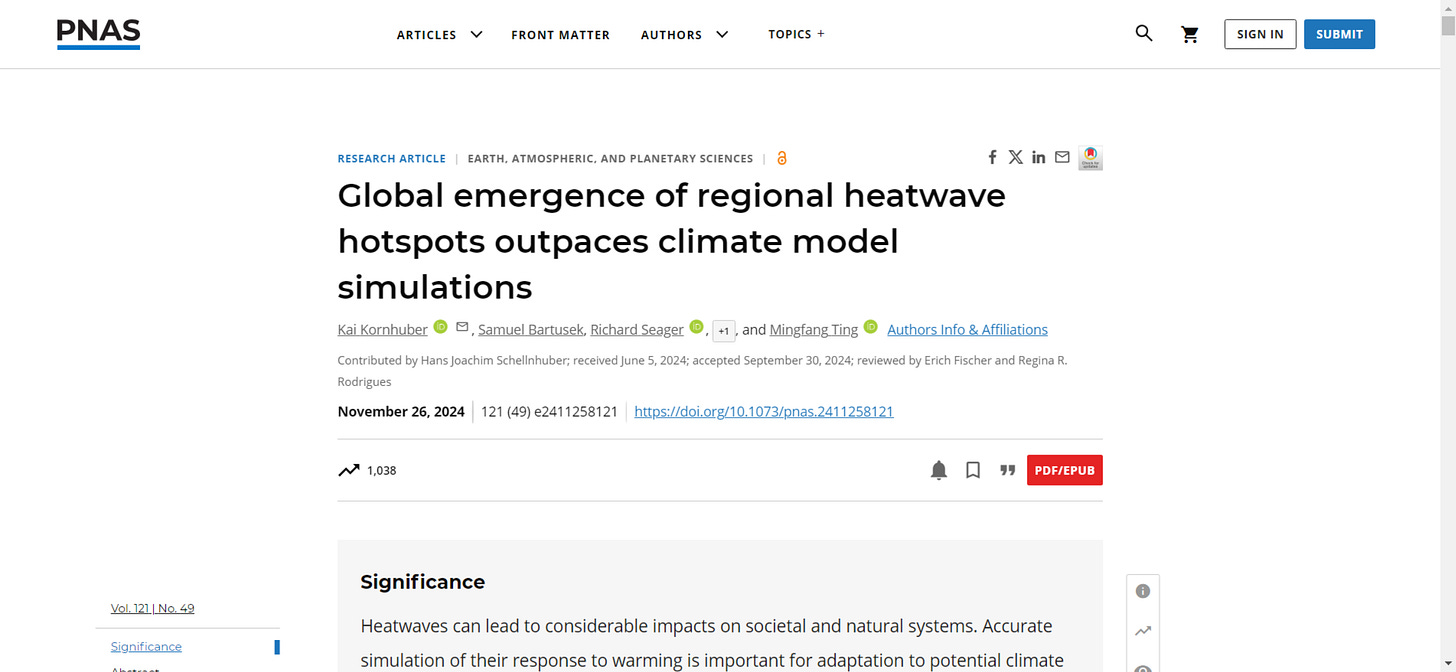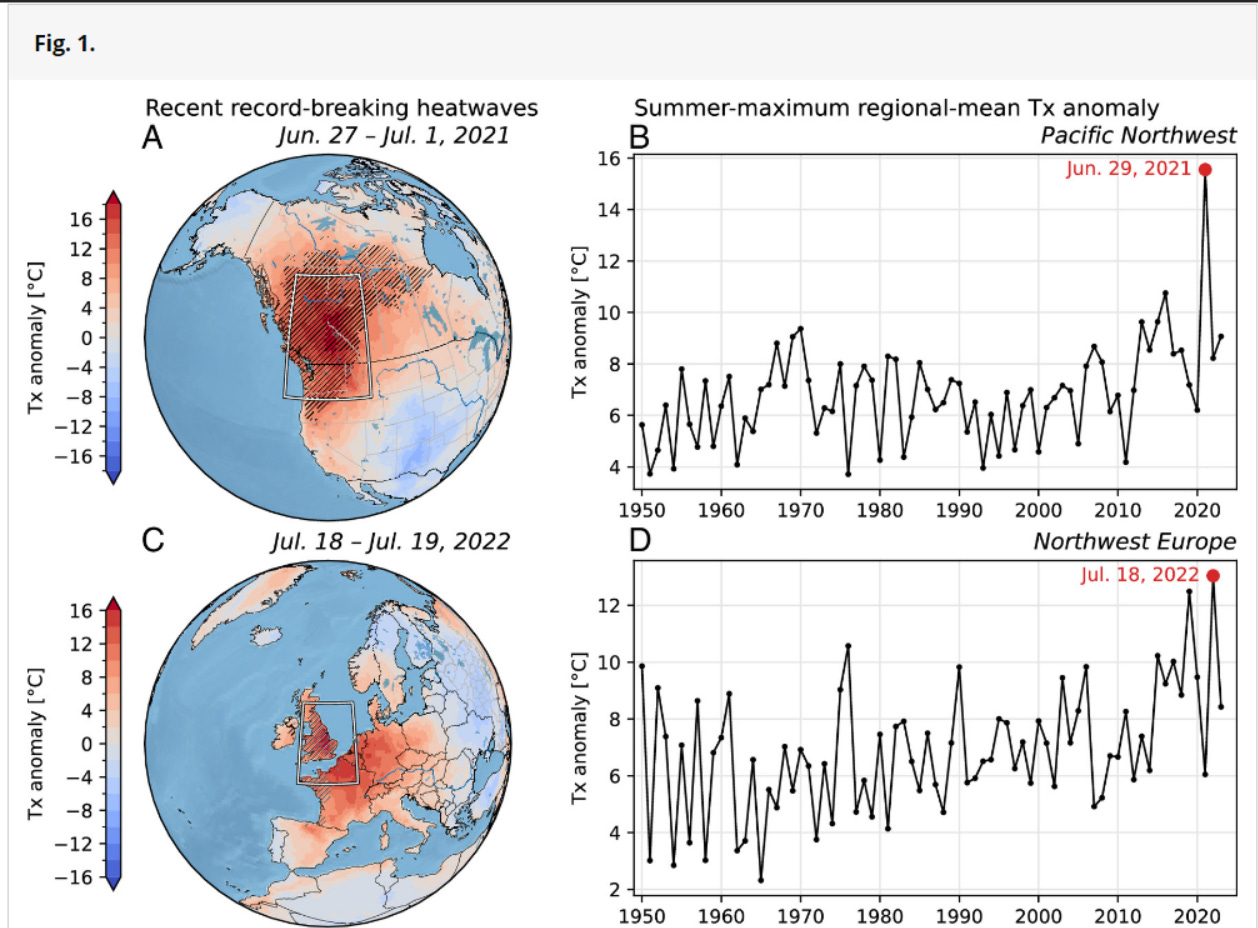This map appears in an article published by climate propaganda website Carbon Brief on 18th November:
Obligingly picked up by the climate propaganda Guardian the same day of course:
The Guardian says this about extreme heatwaves:
The most striking findings are of extreme heatwaves that would have been impossible without global heating, because they have no historical precedent and do not happen in model simulations without the added heat from human-caused climate change. That is as close to saying global heating caused the heatwave as makes no difference. At least 24 previously impossible heatwaves have already struck around the world, from Europe to North America, Africa and east Asia.
Or, as Carbon Brief puts it:
This latest iteration of the interactive map (below) includes more than 600 studies, covering almost 750 extreme weather events and trends.
Across all these cases, 74% were made more likely or severe because of climate change. This includes multiple cases where scientists found that an extreme was virtually impossible without human influence on global temperatures.
For the sake of brevity, but also because extreme heat has been, and still is, the most popular extreme weather event to be attributed to an imaginary ‘climate crisis’, I’m going to focus only on heatwaves in this post, in order to illustrate how Carbon Brief’s extreme weather attribution map - and the Guardian’s reporting of it - is bogus.
First of all, let’s examine a couple of specific events which Carbon Brief claims are examples of these impossible events:
The Pacific NW Heatwave of June 2021
I’ve written extensively about this heatwave, here, here, here, here and here. It’s not so much that I am obsessed by it, it’s that they are obsessed by it - because the Pacific NW was so extreme, and it has attracted so much attention because of that, with numerous research papers published attempting to explain the reasons why, with most of them attributing a significant role for man-made climate change of course.
For our purposes here, we need only focus on two things: the claim made by Carbon Brief re. attribution of this heatwave, plus a counter claim of attribution made in the peer-reviewed literature. CB’s 18th November article has this image and a prominent link re. the Pacific NW heatwave:
The link takes you to another CB article which says:
The deadly heatwave that hit north-western US and Canada in late June would have been “virtually impossible” without human-caused global warming, a new “rapid-attribution” study finds.
The event, which saw temperature records shattered by as much as 5C, has been linked to hundreds of deaths in the Pacific north-west region.
The heatwave was “so extreme” that the observed temperatures “lie far outside the range” of historical observations, the researchers say. Their assessment suggests that the heatwave was around a one-in-1,000-year event in today’s climate – and was made at least 150-times more likely because of climate change.
But that rapid attribution study by World Weather Attribution was subsequently, comprehensively, and convincingly, debunked by a study I wrote about here:
Revisiting The Exceptional Pacific North West Heatwave Part 3
A study was published in November 2022. It says this about the World Weather Attribution rapid analysis which the media obligingly picked up on and amplified as ‘the scientific truth’ thereafter (readers need only read the bold):
But it’s not just one study (though this was very definitive in its debunking of the climate alarmist narrative re. the Pacific NW heatwave); many other studies have pointed to the ‘impossibility’ of the PNW heatwave occurring even with the supposed influence of man-made global warming on the regional temperature trend. It was just too extreme and therefore not explicable; in fact many have given up on the attempt and describe it simply as a ‘Black Swan’ - which is basically a one in a million event which could not have been predicted and is therefore essentially ‘impossible’ according to conventional wisdom. But Carbon Brief (Oxygen Thief) and the Guardian persist in lying to their readers by saying it would have been ‘impossible without climate change’ which, as the Guardian dishonestly points out, therefore means that climate change essentially caused the heatwave. No, it didn’t. That is a lie. The Guardian lied even more specifically and egregiously by saying that the PNW heatwave would not “happen in model simulations without the added heat from human-caused climate change.” In actual fact, the models failed to simulate the PNW heatwave even with the additional heat from so called climate change! I wrote about that here:
NW Pacific Heatwave Attribution - Multiple Climate Model Failure
The authors describe the models used thus:
As I pointed out, none of the climate models used in WWA’s rapid attribution analysis managed to capture the intensity of the event:
Note that the observed change intensity of the heatwave in the study area is 3.1C, according to observations (ERA5*). The best estimate modelled change in intensity is anywhere between 0.22C and 2.6C, i.e. none of the models actually capture the observed change in intensity. The mean best estimate change in intensity of all the models is 1.77C, which is just 57% of the actual observed change. Thus, the models don't come close to simulating actual reality. But again, this does not deter the authors from going ahead with an attribution anyway. They call it a hazard synthesis. I call it a hazardous synthesis!
*Strictly speaking, ERA5 synoptic data is still model data but it is dominated by observational data at short intervals, so it’s a reliable estimate of the actual event as it occurred in real time.
40C UK Mini Heatwave of July 18-19 2022
The cult leader authors at Oxygen Thief also refer to the ‘virtually impossible’ 2 day ‘heatwave’ on the tarmac at RAF Coningsby in July 2022. OK, 40C wasn’t only measured on the runway at RAF Coningsby in Lincolnshire, the record was broken in several other places too, but the Coningsby spot reading of 40.3C has become a bit of a standing joke now, given that it was recorded at an active airport, with Typhoon jet fighters taking off and landing regularly. Chris Morrison at the Daily Sceptic wrote about the dubious legitimacy of the high temperature reading here, pointing out also that 4 of the other 5 stations which recorded 40C+ that day were also suspect. But anyway, WWA did their usual rapid attribution analysis and concluded, once again, that the temperatures recorded would have been ‘virtually impossible’ if us naughty people had not persisted in drinking milk from farty-burpy dairy cows, keeping warm in winter with gas-fired central heating and driving around in ridiculous cars which take only minutes to refuel at petrol stations and where you can actually use the hot air blower in winter! You know, the kind which used to be made by Vauxhall in Luton.
This is the study, which concludes that, without man-made climate change, the UK July 18-19 mini heatwave would have been ‘extremely unlikely’:
I wrote about it here:
UK Heatwave Attribution II
Yep, that is the basic conclusion of the experts’ rigorous statistical analysis of the two day extreme heatwave which occurred in parts of the UK on the 18th and 19th July. Even the all singing, all dancing, super sophisticated climate models running on mega expensive main frame computers using enough energy to power a small town concluded that it was a…
The authors of the attribution study found, just like with the PNW heatwave, that temperatures measured at two of the weather stations were so extreme as to be statistically impossible! So what did they do? They tortured the statistical distribution until the pips squeaked so they could fit the impossible temperatures into a new statistical distribution which still made them extremely unlikely but not impossible. Then they attributed man-made global warming to the occurrence of the impossible temperatures! No, I’m not joking:
So there you go. Using their GEV fit, the authors of this current attribution study make the above assumptions (i.e. they exclude the probable) and they find that, in 2 stations out of 3, the temperatures recorded would be impossible even in a world which is 1.2C warmer due to global warming! Thus, they have to shoe-horn those ‘impossible’ extreme temperatures into a new statistical distribution in order to arrive at realistic probabilities of the return times.
Again, as with the PNW heatwave, the models all failed to simulate the intensity of the event as well, but that didn’t deter WWA, and it hasn’t deterred Carbon Brief in November 2024 from citing the study as yet another example of a heatwave which would supposedly have been impossible without climate change. Fraudsters.
There is obviously something very amiss here. The models and the statistical analyses fail miserably to account for the observed 2 day extreme temperatures and especially the 40C+ temperatures recorded very briefly on the 19th. Something else is going on. It’s not global warming. My guess is that it is a combination of changing atmospheric circulation patterns, increasing urban encroachment upon weather stations and changes in land use, all contributing to the very high temperatures observed.
But hey, when you’re a climate ‘scientist’ and your models don’t work and your statistical analysis requires you to make the impossible possible, then you just say it was Climate Change (TM) wot dunnit regardless; therefore we should be afraid, be very afraid, because even the Science (TM) underestimates the severity of what’s happening.
Which brings me onto another study published 8 days after the fraudulent Oxygen Thief analysis of global weather extremes, which also talks about the recent occurrence of extreme heatwaves globally.
The authors point out that these heatwaves, which have tended to occur repeatedly in so called ‘heatwave hotspots’ are not well simulated by “state of the art” climate models. My response to that would be: “Well, that being the case, they’re not really ‘state of the art’ then, are they Sherlock?”
Multiple recent record-shattering weather events raise questions about the adequacy of climate models to effectively predict and prepare for unprecedented climate impacts on human life, infrastructure, and ecosystems. Here, we show that extreme heat in several regions globally is increasing significantly and faster in magnitude than what state-of-the-art climate models have predicted under present warming even after accounting for their regional summer background warming. Across all global land area, models underestimate positive trends exceeding 0.5 °C per decade in widening of the upper tail of extreme surface temperature distributions by a factor of four compared to reanalysis data and exhibit a lower fraction of significantly increasing trends overall. To a lesser degree, models also underestimate observed strong trends of contraction of the upper tails in some areas, while moderate trends are well reproduced in a global perspective. Our results highlight the need to better understand and model the drivers of extreme heat and to rapidly mitigate greenhouse gas emissions to avoid further harm from unexpected weather events.
In other words, in all these ‘hotspots’, extreme high end temperatures are outpacing the climate model predictions which are predicated on GHG caused global warming - from which one may deduce that man-made global warming is not responsible for these extremes or the models are wrong Sherlock! The authors’ hotspot map bears a striking similarity to Oxygen Thief’s map above:
In particular, the ‘hotspots’ in north west Europe, north America and China. Sherlock again springs into action to suggest that this implies that the climate changed extreme heatwaves which the CB oxygen thieves are waffling on about are the same extreme heatwaves which Kornhuber et al identify as not being well simulated by the all singing-all dancing state of the art climate models! Hmmm.
But it gets worse - CB have been caught with their pants down, exposing their Carbon Briefs, and they’re pretty skimpy to be honest. For a start, the authors refer specifically to the PNW heatwave and the summer heatwaves of 2022 in Europe, which included the UK 40C heatwave:
The frequency and magnitude of extreme weather events that exceeded the margins of local and regional climatology by multiple SD in recent years have caused substantial impacts on ecological and social systems and attracted much attention in the public and scientific domain. Early examples of such “record-shattering” heat events (1) include the European and Russian heatwaves of 2003, 2010, and 2018 (2–6) and the Siberian heatwave of 2020 (7, 8). More recently, the extreme 2021 heatwave struck the North American Pacific Northwest (9–11) (Fig. 1 A and B) and the sequential European heatwaves of 2022 (Fig. 1 C and D).
The authors are even kind enough to show us them on a map and in graph form:
The climate models are not just a bit wrong in simulating observed regional trends in temperature extremes, they’re very wrong, and it’s not just hot temperatures which they fail to simulate accurately (as noted in the Abstract quoted above):
We find that for positive trends, models underestimate the land area exhibiting an occurrence of positive tail-widening trends exceeding 0.5 °C per decade by a factor of four.
Tail end extremes are increasing over a lot of the world’s land surface but there are large areas where they are actually declining, most notably in Siberia and North Africa. The model projections in these areas exceed the observed trend. The CB oxygen thieves don’t have anything to say about these areas.
Their map shows a tiny little red spot with no number in north Africa and a huge grey area of nothing in Siberia. I wonder why? Perhaps because Kornhuber et al’s maps show these areas as dark blue, not red hot crimson! There’s an even tinier red spot in the Antarctic Peninsula but the rest of the continent is a dull, featureless grey. Siberia, North Africa and the Antarctic continent is rather a large area of land mass to just conveniently leave out of your global analysis of allegedly climate changed extreme weather in my opinion!
Kornhuber et al suggest several reasons for the increase in temperature extremes which are not directly related to a generalised increase in mean temperature:
Dry soils and associated land–atmosphere feedbacks are major heatwave drivers (9, 19, 36). It has been found that an amplified warming trend of hot days vs. mean warming in the tropics can largely be explained by a “dry gets hotter” mechanism (37), while precipitation trends were found to govern the occurrence of hot-dry extremes globally (38).
Specifically for the NW European hotspot, they pinpoint atmospheric circulation (dynamics) as the key driver:
Persistent high-pressure systems, which materialize as local blocking patterns (41) or zonally elongated stationary Rossby waves (3, 42, 43) are important contributors to weather extremes especially in the mid-latitudes (44). Atmospheric circulation is considered a major source of uncertainty which also affects precipitation trends (Shepherd, 2014) and, hence, surface water and energy balances and temperatures. Specifically, Europe has been identified as a global heatwave hotspot (31), where the hottest days of the year are warming twice as fast as mean summer days (30), a trend that is driven by atmosphere dynamical patterns (31, 34) and is largely missed by climate models (32).
The link between climate change and atmospheric blocking is tenuous at best and the climate models do not simulate observed changes at all well, so again, they are either wrong or changes in dynamical weather patterns are not primarily driven by the long term trend in surface temperature:
Although the newest generation of climate models shows some improvement in the representation of the frequency and magnitude of atmospheric blocking (41, 47, 48), these measures are still underestimated in CMIP6 models (49). Recent research has shown that while models do accurately reproduce the location and strength of upper-level wave patterns, they also substantially underestimate the surface response to quasistationary wave patterns of the type involved in several of recent extreme weather events, e.g., the European heatwave of 2003 (50, 51).
Sea surface temperatures and ENSO are also suggested as having an influence upon extreme heatwaves, but again, models drastically fail to capture the observed variability:
Persistent and extreme heat has particularly increased over western and southern North America (31, 56). Tropical Pacific SSTs exert a powerful control on climate and weather variability worldwide, primarily via El Niño-Southern Oscillation (ENSO) cycles. El Niño has been suggested as a potential contributor to some extreme heat and precipitation in the Northern mid-latitudes in summer 2023 (13). Further, it is known that a La Niña-like SST trend in the tropical Pacific has contributed to the two-decades-long megadrought in southwest North America (57). ENSO events also have an important role in favoring specific heat extremes such as the 2010 heatwave in Russia which was associated with a La Niña-like SST pattern (52). State-of-the-art climate models predict that rising greenhouse gas emissions (GHG) should reduce the west-to-east warm-to-cool SST gradient across the equatorial Pacific while, in observations, the gradient has strengthened over recent decades along with rising GHG concentrations (58, 59). Regional biases in heatwave intensification may therefore be partially linked to diverging SST signals in models and observations and how they teleconnect to precipitation and temperature worldwide. However, since bias reduction in SST-forced experiments is small, this cannot be the sole explanation (Fig. 3 and SI Appendix, Fig. S5).
In summary, Carbon Brief’s ‘hot spots’ of supposed climate changed extreme weather are nothing of the sort; they are regional anomalies where tail end extremes are increasing much faster than is predicted by ‘state-of-the-art’ climate models and the reason this is happening in these areas is very likely linked not to man-made climate change but to poorly understood natural climate and weather variability:
In large and densely populated areas such as western Europe and China and other areas that feature important biomes for the world climate such as the Amazon, and polar regions around Greenland and Canada, some of which have been discussed in the context of climate tipping points (65, 66), the multimodel mean of climate simulations of the past decades does not show the enhanced warming of the temperature distributions’ upper tails observed in these regions (Fig. 1 and SI Appendix, Fig. S5). Note that for the Amazon, the strongest trends have emerged over the past 23 y and are found for ERA5 only (SI Appendix, Fig. S4).
However, disentangling the relative importance of externally forced and internal variability in the observed trends may be key to attributing the sources of model–observation discrepancies. Coordinated single forcing large ensemble experiments such as the new Large Ensemble Single Forcing Model Intercomparison Project (LESFMIP) (73) might help in improving our understanding in the relative role of various external or internal drivers in extreme event trends.
But then, after going through all that, the authors make the following utterly absurd end statement, which can only mean that they were obliged to give a nod to the carbon reduction cult in order to get their paper published:
While our findings provide many avenues for interesting and relevant new research, the authors stress that the best way to reduce both uncertainty in and exposure to climate impacts is a rapid transition of relevant societal sectors away from fossil fuels to stabilize global temperature rise.
Ludicrous!
















It’s obvious just by eyeballing the UAH satellite temperature chart (the only global series that hasn’t been fiddled) that these people are making it up/lying about alleged man-made global warming extreme events. If you ignore natural ENSO events (2016 and 2020) and the current water vapour-induced, definitely not man-made Hunga Tonga warming spike, there has been negligible global warming since about 1998, in fact a slight downtrend measured from the 1998 peak prior to Hunga Tonga kicking in: https://www.drroyspencer.com/wp-content/uploads/UAH_LT_1979_thru_October_2024_v6.1_20x9-scaled.jpg.
I remember one February thirty or more years ago having lunch in shirt sleeves in the back garden. So what! A scientist whose name I’ve forgotten did a simple statistical calculation to show that when you cherry-pick globally, exceptional weather events are very common.
The entire climate alarmist establishment is made up of bought-and-paid-for professional liars.
Christy has a slide at 37:35 in the attached presentation that talks about the high temp in the North West
https://youtu.be/TwYVyU_q9Uo?si=UGsysVxAnhQ9Fmt9